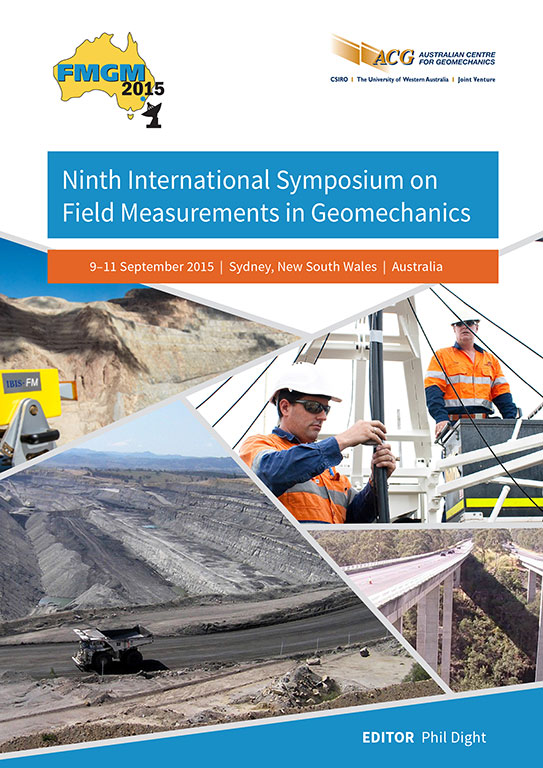Increasing reliability in terrestrial laser data for slope failure monitoring

|
Authors: Afana, A; Hunter, G; Rosser, N; Williams, J; Hardy, R |
DOI https://doi.org/10.36487/ACG_rep/1508_60_Afana
Cite As:
Afana, A, Hunter, G, Rosser, N, Williams, J & Hardy, R 2015, 'Increasing reliability in terrestrial laser data for slope failure monitoring', in PM Dight (ed.), FMGM 2015: Proceedings of the Ninth Symposium on Field Measurements in Geomechanics, Australian Centre for Geomechanics, Perth, pp. 809-818, https://doi.org/10.36487/ACG_rep/1508_60_Afana
Abstract:
Terrestrial laser scanning (TLS) has provided new capabilities for real-time slope failure monitoring. For the mining industry, the advantages of TLS are not limited to deformation monitoring but also include a wide range of geotechnical and surveying applications such as characterising rockfall, 3D rock mass structure, and delineating features. Precision, repeatability and accuracy are crucial for deformation measurement. However, TLS data is affected by local climatic variations, such as fluctuations in temperature, rainfall, humidity, irradiance, and ambient light conditions. This is widely observed in open pit mines where high ranges (>2 km), often high temperature gradients and extremes, and steep topography result in highly variable measurement quality. As such, diurnal variations in ranging precision from TLS systems in such locations can reach up to 30-40 millimetres in some cases. A direct-Fourier transformation method applied to sequentially captured time-series of TLS data is proposed to overcome such variability. By modelling diurnal fluctuations in range from independently monitored environmental variables, it is possible to estimate the frequency and phase characteristics of these effects. Discrimination between deformation and environmentally modulated cyclicity is achieved by modelling out trends in the TLS data. Results contribute to improving the precision of slope failure warning systems as a tool to enhance safety procedures for sustainable mining activities.
References:
Abellán, A, Jaboyedoff, M, Oppikofer, T & Vilaplana, J 2009, ‘Detection of millimetric deformation using a terrestrial laser
scanner: experiment and application to a rockfall event’, Natural Hazards and Earth System Science, vol. 9, pp. 365-372.
Altuntas, C & Yildiz, F 2013, ‘Point cloud registration and virtual realization of large scale and more complex historical structures’, ISPRS-International Archives of the Photogrammetry, Remote Sensing and Spatial Information Sciences, vol. 1, no. 2, pp. 13-18.
Bae, KH & Lichti, DD 2004, ‘Automated registration of unorganised point clouds from terrestrial laser scanners’, in O Altan (ed.), International Archives of Photogrammetry and Remote Sensing (vol. XXXV: Part B5), Proceedings of the ISPRS Working Group V/2, International Society for Photogrammetry and Remote Sensing, pp. 222-227.
Diodato, N & Bellocchi, G 2011, ‘How predictable are temperature-series undergoing noise-controlled dynamics in the Mediterranean, Nature Precedings, 9 p.
Jaboyedoff, M, Oppikofer, T, Abellán, A, Derron, MH, Loye, A, Metzger, R & Pedrazzini, A 2012, ‘Use of LIDAR in landslide investigations: a review’, Natural hazards, vol. 61, pp. 5-28.
Lichti, D, Gordon, S & Stewart, M 2002, ‘Ground-based laser scanners: operation, systems and applications’, Geomatica, vol. 56, no. 1, pp. 21-33.
R Core Team 2015, R: A language and environment for statistical computing, Reference Index, R Foundation for Statistical Computing, Vienna, 3604 p.
Soudarissanane, S, Lindenbergh, R, Menenti, M & Teunissen, P 2009, ‘Incidence angle influence on the quality of terrestrial laser scanning points’, ISPRS Workshop Laser Scanning, 6 p.
Statistics Netherlands 2010, Distribution based outlier detection for univariate data, Technical Report 10003, prepared by MPJ Van der Loo, Heerlen.
Theiler, PW & Schindler, K 2012, ‘Automatic registration of terrestrial laser scanner point clouds using natural planar surfaces’, in M Shortis, N Paparoditis & C Mallet (eds), Proceedings of the ISPRS Annals of the Photogrammetry, Remote Sensing and Spatial Information Sciences Congress (vol. I-3), International Society for Photogrammetry and Remote Sensing,
pp. 173-178.
Tournas, E & Tsakiri, M 2008, ‘Deformation monitoring based on terrestrial laser scanner point cloud registration’, Proceedings of the 13th FIG Symposium on Deformation Measurement and Analysis, 10 p.
Vinikov, KY, Grody, NC, Robock, A, Stouffer, RJ, Jones, PD & Goldberg, MD 2006, ‘Temperature trends at the surface and in the troposphere’, Journal of Geophysical Research, vol. 111, no. D3.
© Copyright 2025, Australian Centre for Geomechanics (ACG), The University of Western Australia. All rights reserved.
View copyright/legal information
Please direct any queries or error reports to repository-acg@uwa.edu.au
View copyright/legal information
Please direct any queries or error reports to repository-acg@uwa.edu.au